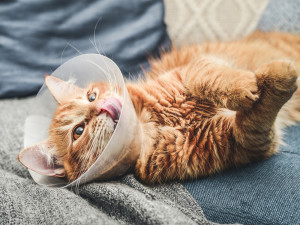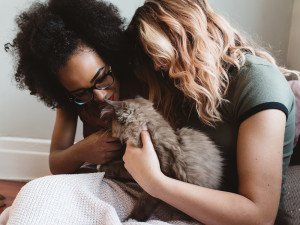How Much Does It Cost To Get a Cat Fixed?
And why it’s important to do.

Share Article
In This Article:
Why Are Spaying and Neutering So Important for a Cat’s Health?opens in a new tab What Impacts the Cost of Spaying and Neutering a Cat?opens in a new tab How Much Does It Cost To Get A Cat Spayed?opens in a new tab How Much Does It Cost To Get A Cat Neutered?opens in a new tab
The cost to have a cat spayed or neutered will vary greatly based on a number of factors, and it is possible to find services ranging from free programs to surgeries that may cost hundreds of dollars. While free services are great news for many cats and their pet parents, there are situations in which a cat’s unique needs may require a higher level of pre and post-surgical care.
Read on to learn all about the different services offered for cat spaying and neutering procedures.

littleKin™ is Kinship’s home just for puppy and kitten parents. Bop over to check out expert advice, new pet tools, and special deals—all curated for your newest family member.
opens in a new tabWhy is spaying and neutering so important for a cat’s health?
Sometimes, pet parents wonder whether spaying or neutering their cat is really necessary, and they may worry about the risks and costs associated with the procedures, but this is a case where knowledge is power.opens in a new tab The more you learn about spaying and neutering, the more you can make an informed decision for your pet.
When it comes to health and behavior benefits, spaying and neutering provides many important advantages for cats. First, female cats who are not spayed will go into heat routinely. If you’ve ever seen or heard a cat in heatopens in a new tab, you know you don’t want to live with one. They are extremely vocal, restless, needy, and often desperate to try to sneak out to look for mating opportunities.
If they do manage to sneak out, they are very likely to get pregnant and can have multiple litters of kittens each yearopens in a new tab, which can be a drain on a family’s resources and contribute to the overpopulation problem of cats. Additionally, female cats who are not spayed are at risk for certain life-threatening reproductive conditions including infections of their uterus, known as a pyometra, and a highly aggressive type of breast canceropens in a new tab known as mammary adenocarcinoma.
When it comes to male cats, it usually doesn’t take much convincing to encourage pet parents to neuter their cats. This is because intact (or non-neutered), male cat urine has a really strong, unpleasant odor, and intact male cats are notorious for spraying, or urinating all over the placeopens in a new tab to mark their territory. Intact male cats also tend to develop unwanted behaviors that may lead them to get into fightsopens in a new tab with other cats and to try to sneak out of the house to mate, all of which put them at risk for accidents and injuries that can be life-threatening. Intact male cats are also at risk for reproductive health problems like testicular cancer.
Sadly, behavior problems are also a leading reason that cats are re-homed or brought to animal shelters, and many times, spaying and neutering could have prevented those challenges. For all of these reasons, veterinarians and animal welfare experts strongly encourage the spaying and neutering of cats. The good news is this has led to many subsidized programs that offer free or low-cost spaying and neutering so pet parents can access these important services.
What impacts the cost of spaying or neutering a cat?
There are many factors that will impact the cost of spaying or neutering a cat. First, it is worth mentioning that spaying, or the surgery to remove a female cat’s ovaries and uterus, tends to be more expensive than a neutering a male catopens in a new tab, during which the testicles are removed. This is because a spay is a more invasive procedure that takes longer and requires more resources and equipment. Other factors that will affect the cost of surgery include:
Location: Prices vary in different parts of the country, just like prices for other goods and services. If you live in an area that tends to be expensive in general when it comes to real estate, dining, and other services, expect that costs for veterinary care may also be comparatively pricey.
Facility: The range of services and level of pre- and post-operative care also influences the price of surgery. Low-cost and free spay/neuter facilities are often associated with animal shelters or other nonprofits, and they use techniques known as high-quality high-volume spay and neuter. This means that they use techniques known to be safe and aimed at making surgery as quick and low-cost as possible to maximize the number of animals that can be spayed and neutered. Therefore, there are more animals under their care at any given time, and each animal gets less individualized attention. On the other hand, private veterinary clinics may only have a few animals scheduled for surgery on a given day. This allows them to take their time providing one-on-one individualized attention, planning, and post-operative care to each pet, which of course, comes with the higher cost of service.
Health and age of the cat: A cat’s overall health and medical needs will also influence the cost of surgery as well as what types of facilities can perform their surgery. Young, healthy cats opens in a new tabwith no underlying medical conditions are the best candidates for high-quality, high-volume spay and neuter operations, because they don’t need as much individualized attention.
Many of the low-cost or free clinics will not perform surgery on animals over a certain age or animals with underlying health conditions; these animals need additional pre-surgical testing and post-operative care. This includes bloodwork or evaluation of their heart, to make anesthesia and surgery as safe as possible for them, which carries additional costs. Other conditions like cryptorchidism, a testicle that never descended, or pyometra will make surgery more complicated and therefore add additional costs to the procedure as well.Pet insurance or medical plans: Other ways to reduce the costs of spay and neuter surgeries may be through pet insuranceopens in a new tab or bundled health care packages at certain veterinary clinics. Some clinics may offer reduced fees if you sign up for their health care packagesopens in a new tab so it is worth contacting multiple clinics and pet insurance carriers to find out your options.
Complications: Unexpected complications can also affect the overall cost of spays and neuters. Cats can develop complications such as bleeding, infections, or incisions that don’t heal properly, requiring additional care and expenses for their recovery.
Aftercare costs: Expected aftercare costs are usually built into the price you are quoted for surgery and may include add-ons like pain medication and an Elizabethan collar (or cone) to prevent cats from licking at their incision. Many clinics also offer other services that can be done at the time of the surgery including vaccines or placing a microchipopens in a new tab, which will have additional costs. If you are comparing the costs of surgery at different clinics, be sure to compare these aftercare costs and options as well.
How much does it cost to get a cat spayed?
Depending on where you live and whether you are considering a low cost spay/neuter clinic versus a private veterinary clinic, the cost will vary. Some spay/neuter clinics may be completely free of charge while others charge a small fee between $50 to $150. In a private clinic, you can expect to pay more than this in most cases, with charges ranging from a few hundred dollars up to many hundreds of dollars depending on the type of pre-surgical and post-surgical care required.
How much does it cost to get a cat neutered?
Cat neuters typically cost less than cat spays, given that they are quicker procedures and require less equipment. Once again, the exact cost will depend on the type of clinic doing the procedure, and whether additional pre- or post-operative services are provided. Many of the low-costopens in a new tab spay/neuter clinics may be free for pet parents in need and others charge a small fee in the range of $50 to $150. In a private clinic, charges can reach a few hundred dollars, especially for cats that need specialized care due to underlying medical conditions.
Can I get my cat spayed or neutered for free?
The good news is that there are often many resources availableopens in a new tab to pet parents looking for free or low-cost options for spay and neuter services. Typically, these services are provided through animal shelters and nonprofits working to reduce the overpopulation of stray cats, eliminate preventable reproductive diseases, and keep pets in their homes.
Pet parents can search the SpayUSA databaseopens in a new tab to find out what options are available in their area. It can also help to ask around at local vet clinics as they may know of, or work with, local organizations that provide these services. Finally, if you are considering adopting a new catopens in a new tab and are hoping to have them spayed or neutered for free, be sure to check out local animal shelters and pet rescue organizations. Most animal shelters and rescue groups will cover the cost of spays and neuters prior to adoption to ensure that all animals in their care are spayed and neutered.
Bottom line
Spaying and neutering is an important part of responsible pet parenthood.
The cost for this surgery can vary greatly depending on where the surgery is performed and the medical needs of a specific cat.
There are many low-cost and free options available for spays and neuters so be sure to check out resources in your area.
References
Brooks, W. “Neutering your Male Catopens in a new tab.” Veterinary Partner, 25 November 2024.
Brooks, W. “Spaying your Female Cat.opens in a new tab” Veterinary Partner, 9 August 2023.
Bushby, P. “High-quality, high-volume spay-neuter: Access to care and the challenge to private practitionersopens in a new tab.” Journal of Feline Medicine and Surgery, vol. 22, no. 3, March 2020, pp. 208-215.
Nolen, S. “Ensuring the quality of high-volume spay-neuter.opens in a new tab” American Veterinary Medical Association, 16 August 2024.
SpayUSA: Low-cost spay and neuteropens in a new tab. Updated 2025.

Dr. Amy Fox, DVM
Amy Fox, DVM is a small animal veterinarian in New York City. A lifelong animal lover, Dr. Fox studied biology in college and then worked as a veterinary nurse before pursuing veterinary school at Cornell University. She has worked in many different settings including shelter medicine, emergency medicine, general practice, and animal cruelty and forensics. She is especially interested in nutrition, preventative medicine and care for senior pets. Dr. Fox also enjoys writing about veterinary medicine and teaching. In her free time she loves to cook, garden, and go for long runs.
Related articles
![Two women, one with dark curly hair and deep skin and one with pink-blonde hair and lighter skin petting their grey cat]() opens in a new tab
opens in a new tabYes, You Should Spay/Neuter Your Cat. Here’s Why
A veterinarian breaks down how it keeps your pet healthy and curbs kitten overpopulation.
![Cat cleaning themself]() opens in a new tab
opens in a new tabA Cautionary Tale About a Cat in Heat
Experts explain why you should spay or neuter your kitten. Don’t learn the hard way like I did.
![Male and female cat lying side by side.]() opens in a new tab
opens in a new tabHow to Spot the Difference Between Male and Female Cats
There’s more to it than what you learned in health class.
- opens in a new tab
Why Does Your Cat Roll Around On the Floor?
Regardless of the reason, you have multiple photos of it on your phone... so cute.
![Cat playing and jumping with a rubber band]() opens in a new tab
opens in a new tabWhat’s the Deal with FIV in Cats?
The most common questions about feline immunodeficiency virus, answered. Good news: most cats live long, happy lives.
- opens in a new tab
When Can a Kitten Be Neutered?
Learn the benefits of doing so ASAP.







